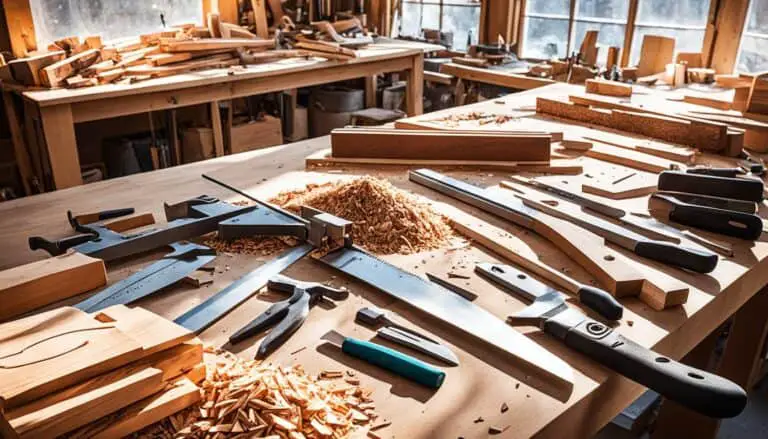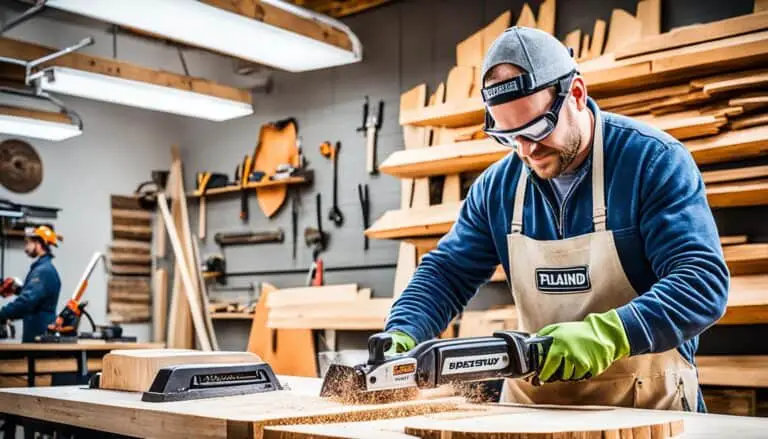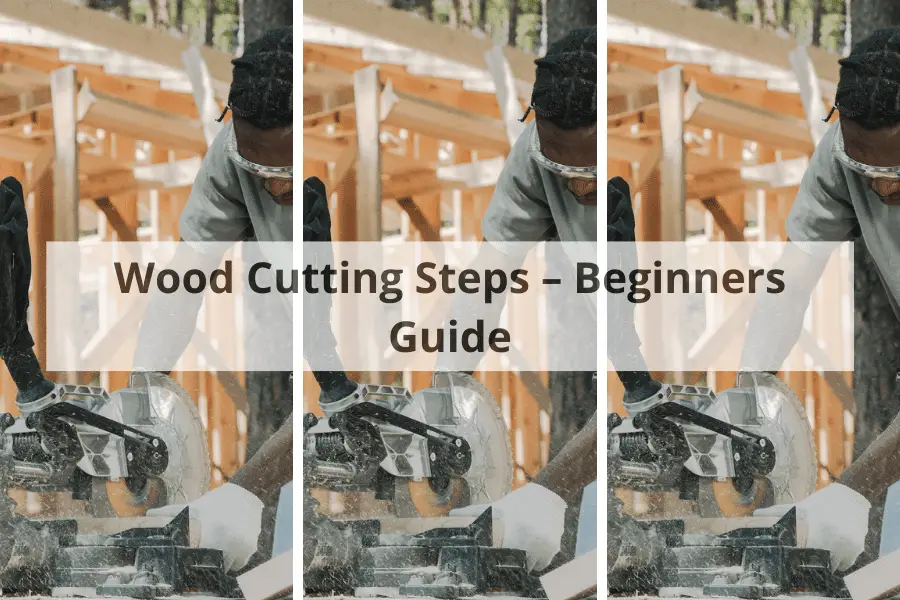
If you are new to wood cutting, there are a few things you should know before getting started. This guide will teach you the basics of cutting wood, including how to select the right tools and how to safely operate them.
Basics Of Wood Cutting
Wood cutting can be done with a variety of different tools such as a hand tool or a power tool. The most common are saws, such as hand saws, miter saw or power saw such as circular saw, and a jigsaw. You will also need a sharp blade or cutting tool of some kind for basic cuts.
When choosing a saw, you will need to consider the type of wood you will be cutting, the thickness of the wood, and the size of the project. For example, a hand saw is best for cutting thin wood, while a circular saw is better for thicker wood boards.
Jigsaws are useful for making curved cuts or cuts in tight spaces. However, they can be more difficult to control than other types of saws and a circular saw can be used for multiple purposes when cutting wood.
Once you have the right tools, you need to know how to use them safely. Always wear protective gear, such as gloves and eye protection, when cutting wood. Make sure the area you are working in is well-ventilated to avoid breathing in wood dust.
When using a saw, always start with the blade pointing away from you. Keep your fingers well away from the path of the blade.
Wood Cutting can be dangerous if you don’t take proper safety precautions. However, with the right tools and knowledge, wood cutting can be a safe and enjoyable activity.
What Kind of Cut Do You Need to Make?
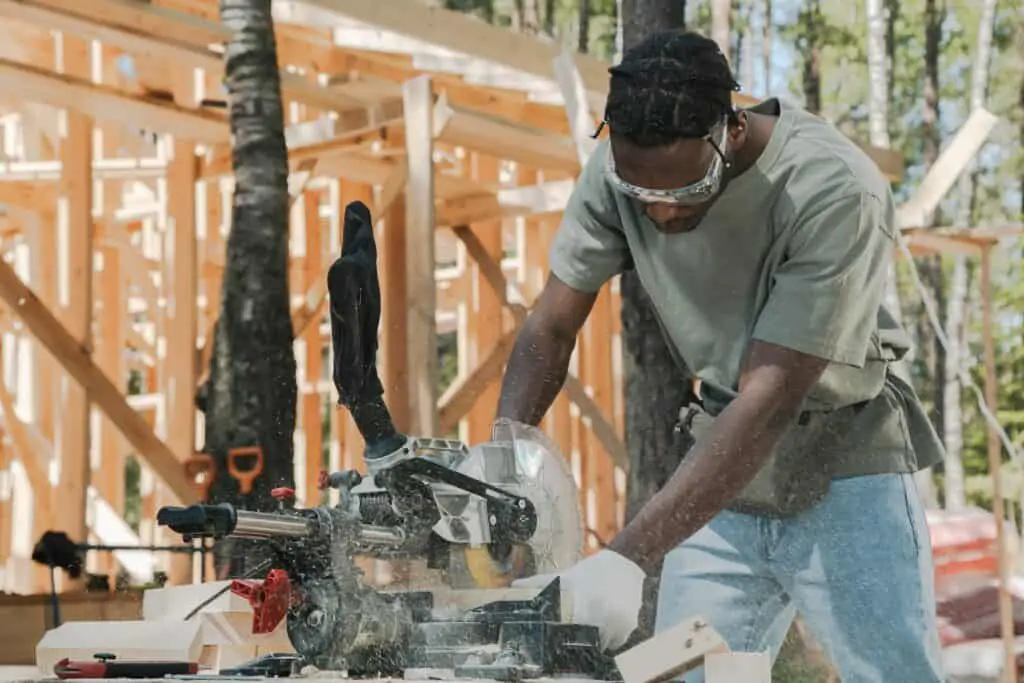
When we look at making cuts for your wood projects there are many different types of woodcuts you can make. Let’s look at the different types of cuts you can make, such as crosscuts, rip cuts, miter cuts, bevel cuts, and compound miter cuts.
The different types of cuts we make to a board can be broken down into two basic functions. Either changing its length or width, which means that sometimes in order for you as a woodworker etc., need to shorter and narrower boards with these techniques.
Types of Cuts
Rip Cut
When you make a rip cut, the board becomes narrower and more uniform in width. This is because it’s made with grain or along its length.
Bevel Cut
Bevel cuts are angled and made on the edge of the wood. The depth and width can be changed with this type of cut to change how long or wide your board is going to get measured. A miter saw or a table saw are excellent for these types of cuts.
Miter Cut
When making a miter cut, the wood is angled across its width or length. This change in dimension can make some boards shorter and others longer depending on what you want to do with them. A miter saw is excellent for these types of cuts.
Crosscut
This type of cut is made across the grain of the wood or across the width of the board making the wood board thinner at its width. A miter saw is excellent for these types of cuts.
Compound Miter Cut
This is the combination of a miter cut and a bevel cut. This is commonly used for trim and baseboard applications. A miter saw is excellent for these types of cuts.
What Kind of Saw Do You Need For Wood Cutting
Learning how to cut wood can be fun. We have reviewed the types of cuts now let’s take a look at what saws or power tools you need to make the cuts to wood.
If you are considering a power saw here are options to look at:
Miter Saws or Mitre Saws
What Type Of Cuts To Wood Does A Miter Saw Perform
- Miter Cuts
- Crosscuts
- Bevel Cuts
- Compound Miter Cuts
Circular Saw
What Type Of Cuts To Wood Does A Circular Saw Perform
- Crosscuts
- Rip Cuts
- Miter Cuts
- Bevel Cuts
- Compound Miter Cuts
- Cuts are more accurate when using a speed square
Table Saws
What Type Of Cuts To Wood Do Table Saws Perform
- Rip Cuts
- Bevel Cuts
- Crosscuts (best with a table saw sled)
- Miter Cuts (best with a table saw sled)
- Great for cutting panels and plywood
Jigsaws
What Type Of Cuts To Wood Do Jig Saws Perform
- Cutting Curves, Circles, and Shapes
- Crosscuts
- Miter Cuts
- Bevel Cuts
- Compound Miter Cuts
Reciprocating Saw
What Type Of Cuts To Wood Does A Reciprocating Saw Perform
- Rip Cuts
- Crosscuts
- Bevel Cuts
- Compound Miter Cuts
- Not as accurate as other power saws
If you are considering a hand saw here are options to look at:
Hand Saw (Generic)
Hand-operated saws are occasionally still used for special niche products or specific purposes such as cutting where a power saw may not work. But don’t discount the hand saw as it can be your best friend in those tight spots or if you want a specific custom effect on your wood project.
Back Saw
This hand saw is used for woodworking joints such as dovetails and tenons. The back saw has a rigid metal spine that acts as a guide for the blade keeping it straighter for more accurate cuts.
Fine Saw
This is a hand saw that is used for making precise cuts in wood. The blade on the fine saw is much thinner than other types of hand saws which makes it easier to cut with precision.
Bow Saw
The bow saw is a hand-operated wood saw that is used for making long, straight cuts in wood. The blade on the bow saw is attached to two handles which are connected by a metal or wood frame.
Coping Saw
The coping saw is a hand-operated wood saw that is used for making very precise, intricate cuts in wood. The blade on the coping saw is very thin and can be turned in different directions to make different kinds of cuts.
Crosscut Saw
The crosscut saw is a hand-operated wood saw that is used for making long, straight cuts across the grain of the wood. The blade on the crosscut saw is very sharp and can be turned in different directions to make different kinds of cuts.
Japanese Saw
The Japanese saw is a hand-operated wood saw that is used for making very precise, intricate cuts in wood. The blade on the Japanese saw is very thin and can be turned in different directions to make different kinds of cuts.
There are many different saws on the market today and each one is designed for a specific purpose.
When choosing a saw, it is important to consider when wood cutting what type of cuts you will be making and what kind of wood you will be cutting. With the right tools, wood cutting can be an enjoyable and rewarding experience.
Battery Powered Saw or Electric Powered Saw
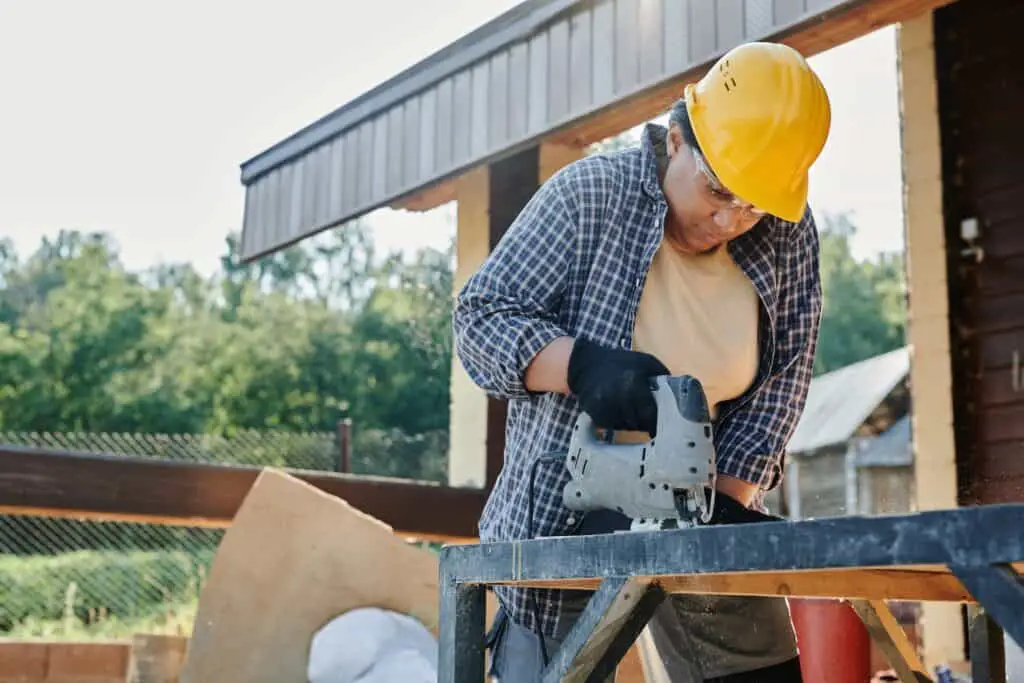
Wood cutting requires the use of different types of saws for different purposes. A jigsaw, miter saw or circular saw are common types of saws that can be used for wood cutting.
Each type of saw has its own unique advantages and disadvantages that should be considered before making a purchase.
We will use the circular saw as an example, however many different types of saws are available both battery-powered and electric.
A cordless or battery-powered circular saw is great for wood cutting because it is lightweight and easy to maneuver. They are also very versatile and can be used for a variety of wood-cutting applications.
A cordless circular saw is more powerful and has longer runtimes than its traditionally powered counterparts. Since professionals in construction often choose these tools over cords, it is important to consider which brand or model would best suit your needs!
The market has seen an increase of brushless motorized models that offer stronger motors with higher torque ratings as well as lithium battery packs offering extra weight savings when carrying around heavy equipment on site without being tethered by long cables (which can get tangled).
Corded circular saws are the go-to tool for cutting large pieces of material up to 1″ thick. They offer incredible power and control, with a variety of materials that can be cut depending on your needs.
Electric-powered saws are ideal for wood cutting because they are powerful and can make precision cuts. Electric saws are also very versatile and can be used for a variety of wood-cutting applications.
When choosing an electric saw, it is important to consider the size and weight of the saw. Electric saws come in a variety of sizes and weights, so it is important to choose one that will be easy to maneuver and handle.
It is also important to consider the type of wood you will be cutting. Some electric saws are only designed for certain types of wood, so it is important to choose one that will work with the type of wood you will be cutting.
Corded saws require an outlet and you need to consider safety – just make sure you know which hand operates it before using one because they’re usually operated by pulling triggers rather than pushing buttons as seen here: lefties or righties respectively (depending).
Types of Blades When You Cut Wood
When wood cutting, you need to use the right type of blade for the specific woodcut you are making.
For example, if you are cutting a hardwood like oak, you will need a different blade than if you were cutting a softwood like pine.
Here is a list of some of the most common types of wood and the best blade to use when wood cutting each type:
– Hardwood: Use a carbide-tipped blade.
– Softwood: Use high-speed steel (HSS) blade.
– Plywood: Use a plywood blade.
– MDF: Use an MDF blade.
– Chipboard: Use a chipboard blade.
– Particle board: Use a particle board blade.
Wood blades come in a variety of sizes, so it is important to choose the right size blade for the saw you are using. It is also important to consider the type of cuts you will be making.
Some wood blades are designed for specific types of cuts, so it is important to choose a blade that will work with the type of wood you will be cutting.
Saw Teeth On Your Blade
The teeth on a wood blade are important because they determine the type of cut the blade will make. For example, a wood blade with more teeth will make a smoother cut, while a wood blade with fewer teeth will make a rougher cut.
It is important to choose the right number of teeth for the type of wood you will be cutting and the type of cut you want to make.
There are three main types of wood blade teeth:
– Rip blades have fewer teeth and are designed for cutting along the grain of the wood.
– Crosscut blades have more teeth and are designed for cutting across the grain of the wood.
– Combination blades have a mix of teeth and are designed for making both rip and crosscut cuts.
When wood cutting, it is important to use the right type of blade for the specific woodcut you are making. For example, if you are cutting a hardwood like oak, you will need a different blade than if you were cutting a softwood like pine.
The Thickness Of The Wood.
For example, if you are cutting a thick piece of hardwood, you will need a different blade than if you were cutting a thin piece of softwood.
Here is a list of some common wood thicknesses and the best blade to use when wood cutting each thickness:
– 1/2 inch thick or less: Use a thin-kerf blade.
– 3/4 inch thick: Use a standard kerf blade.
– 1 inch thick or more: Use a wide-kerf blade.
When wood cutting, it is also important to consider the type of cut you are making.
For example, if you are making a cross-cut, you will need a different blade than if you were making a rip cut.
Safety When You Cut Wood
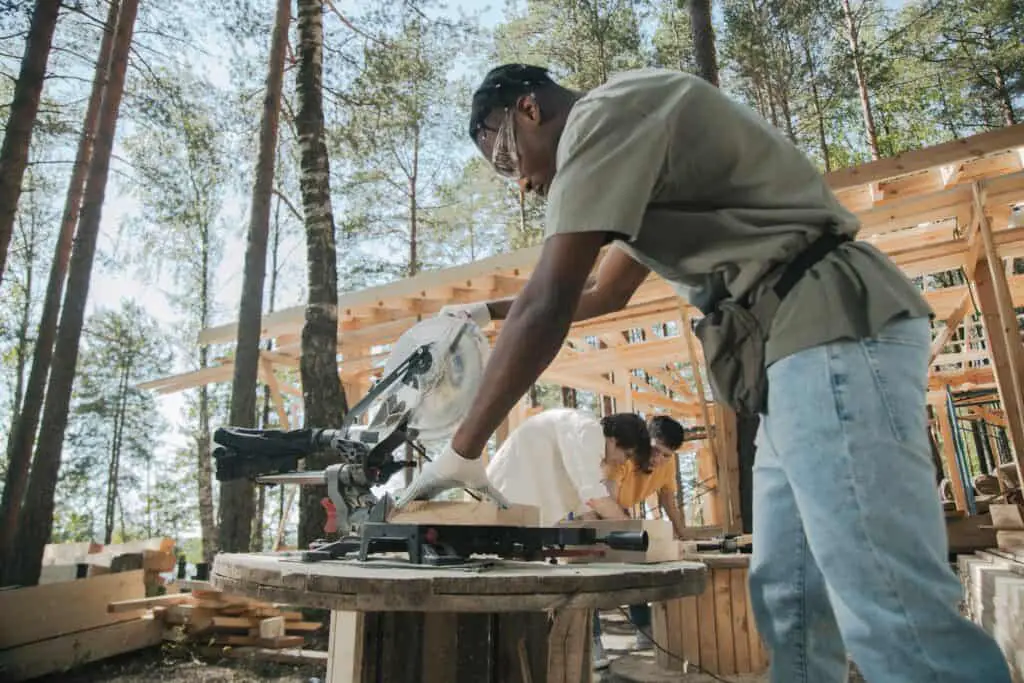
Whenever you are wood cutting, it is important to wear the proper safety gear. This includes safety glasses, ear protection, and gloves.
It is also important to follow the safety instructions that come with your saw. When wood cutting, it is also important to be aware of your surroundings and to make sure that there is nothing and no one in the path of your saw blade.
If you are going to cut wood outdoors, it is also important to be aware of the weather conditions. If it is windy, make sure that you are not going to cut wood near any loose branches that could fall on you.
If it is raining, make sure that you are not going to cut wood near any puddles or standing water.
Handling your saw and wood properly is another important safety consideration. When wood cutting, always make sure that your saw is turned off and unplugged when you are not using it.
When handling wood, always make sure that your hands are dry and free of any oil or grease.
If you are wood cutting with a power saw, always make sure that the saw is properly secured before you begin cutting.
When wood cutting, always cut away from your body and never towards it.
There are a few other things to keep in mind when wood cutting:
– Always use a sharp blade. A dull blade can cause the wood to splinter and can be more difficult to control.
– Make sure that your saw is properly calibrated before cutting. A misaligned saw can cause the wood to splinter.
– When cutting, always use a steady, even motion. Sudden starts and stops can cause the wood to splinter.
With these wood cutting tips, you should be able to make clean, safe cuts. Always remember to wear the proper safety gear and to follow the instructions that come with your saw. With a little practice, you will be wood cutting like a pro in no time.
So if you are going to cut wood it can be a rewarding and enjoyable experience, but it is important to be safe and to use the proper tools and safety gear. With the right preparation, wood cutting can be an easy and fun activity.
How to Cut Wood – Step-By-Step
Okay now you know about cuts and types of saws for wood cutting let’s look at how to cut wood. You will want to make a pencil line mark for your cut after you measure.
However, we want you to stop there. You need to know about the pencil line mark you just made. Are you aware of the term “kerf”? Kerf width of the saw cut when you cut with your miter saws for example.
This will impact the length of your cut if you cut on the mark as opposed to next to the mark.
When woodcutting you need to take into account the “Kerf”. This is the width of the saw blade when cutting on a circular saw for example. This would mean you would cut with the saw on the side of the pencil line mark and not directly on the mark.
Cut A Small Amount Off the End of the Board
When you purchase wood from a box store or local wood supplier we don’t know if the end of the wood is truly square and has a straight edge.
It is always suggested to either check using your square or cut with your Mitre saw to ensure it is square and has straight edges. This will ensure your measurements and wood project will be accurate.
Measure Then Mark Wood
Once you have cut off a sliver of wood on the end of your wood material to make it square you need to mark your wood for cutting.
Marking wood is a simple process and depending on your woodworker each has a different preference on how they mark the wood where some use a pencil line or others will use a marking knife.
Some woodworkers mark with a small line and others use a line completely across the wood material being cut. We suggest the full-length line. Once you mark your wood mark the side of the line which is waste material and an “X”.
Although this sounds simple it does help when you go to place the wood on your saw for cutting and determining which is the piece you want to keep.
Place The Blade On The Wood
Once you have measured your wood for cutting then you will place the saw blade on the wood for cutting.
Remember to place the saw blade on the waste side of the cut line with the “X”. This will ensure your cut is accurate for length or width after you cut it.
Cut The Wood
Gripping the saw correctly, cut the wood, and then allow the blade on your saw to completely come to a stop prior to lifting the saw. After the cut is made measure the wood to ensure you have the correct length.
Review Your Cut
After you cut your wood you will want to look at your cut and ensure you have straight cuts. This of course is to make sure your wood project is aligned to the specs you are going by and a tight fit. Straight cuts can be the downfall of your wood project.
If you don’t have straight cuts you may want to check your saw. Is your blade straight or check your saw for alignment or your methodology of cutting as these can greatly affect your straight cut.
Wood cutting can be a fun and easy experience as long as you are prepared and use the proper tools. With a little practice, you will be wood cutting like a pro in no time.
Frequently Asked Questions
What Is Best For Cutting Wood – A Circular Saw or Miter Saw? This is a great question and one we hear all the time. The answer to these wood cutting tools is it depends on the woodworking project you are working on.
If you are looking for a quick and easy way to make cuts in wood then we would recommend using a miter saw as it will give you clean and precise cuts.
If you need to make more intricate cuts or need to cut thicker wood then we would recommend using a circular saw as it will give you more power and control.
What Type of Blade Should I Use To Cut Wood – The type of wood you are cutting will also determine the type of wood cutting blade you should be using. If you are cutting softwoods we would recommend using a 24-tooth or more woodcutting blade. questions depend on what you are cutting wood for.
If you are looking to make quick cuts for framing then a circular saw would be the best tool. However, if you are looking for accuracy such as for trim work then a miter saw would be the better option.
Does The Type of Saw I Use Matter – As we just discussed the type of wood you are cutting will also determine the type of woodcutting blade you should be using. If you are cutting softwoods we would recommend using a 24-tooth or more woodcutting blade.
If you are looking to make quick cuts for framing then a circular saw would be the best tool. However, if you are looking for accuracy such as trim work then a miter saw would be the better option.
What is The Best Way To Cut Wood – The best way to cut wood is by using a woodcutting blade that is best suited for the type of wood you are cutting. If you are cutting softwoods we would recommend using a 24-tooth or more woodcutting blade.
If you are looking to make quick cuts for framing then a circular saw would be the best tool. However, if you are looking for accuracy such as for trim work then a miter saw would be the better option.
What Is The Easiest Way To Cut Wood – The easiest way to cut wood is by using a woodcutting blade that is best suited for the type of wood you are cutting. If you are cutting softwoods we would recommend using a 24-tooth or more woodcutting blade.
If you are looking to make quick cuts for framing then a circular saw would be the best tool. However, if you are looking for accuracy such as trim work then a miter saw would be the better option.
We hope you enjoyed this woodcutting guide and found it helpful!


